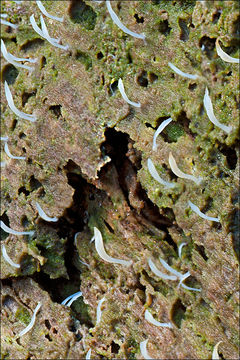Image de Multiclavula mucida (Pers.) R. H. Petersen 1967

Description :
Slo.: ? - syn.: Lentaria mucida (Pers.) Corner, Clavaria mucida Pers. - Habitat: Mixed wood, dominant trees Picea abies, Fagus sylvatica, Fraxinus ornus, Fraxinus excelsior, Corylus avellana; at the foot of steep mountain slope, southeast oriented terrain, locally almost flat ground consisting of overgrown calcareous scree, rocks and boulders; in shade, partly protected from direct rain by tree canopies, average precipitations ~ 3.000 mm/year, average temperature 7-9 deg C, elevation 625 m (2.050 feet), alpine phytogeographical region. - Substratum: large, dead, water soaked trunk of Picea abies in the last stage of disintegration lying on ground. - Comments: Most sources consider this species as rare, however in Bovec region it doesn't seem so. I've found it several times. One could consider it as frequently overlooked species partly because it is really small and because its sporocarps are very ephemeral. However, on other side, it usually thrives gregariously in hundreds of sporocarps, which is, because of their white color contrasting to usually darkly colored rotten wood, quite easy to observe. This interesting fungus grows in symbiosis with algae (Coccomyxa) similar to lichens. While in true lichens algae are internal to fungi body, algae associated with Multiclavula mucida grow externally to the fungus on the same substratum. Algae can be observed like a thin layer of something green spreading around fungi sporocarps. M. mucida is also a rare example of symbiosis of a basidiomycete and algae. Vast majority of lichens is an association of ascomycete with algae. - Growing in groups of many fruit bodies; sporocarps up to 4 - 7 mm high and about 0.8 mm in diameter; most sporocarps are single, but some are branched into 2 (5) tips; no distinctive smell; taste slightly bitter; SP faint, whitish. - Measured spores are definitely wider than they should be for M. mucida (measured spores originated from tiny but clear spore pint produced by the sporocarps). All sources I found consistently state that spore width should not exceed 3.0 (3.2) m. According to the key (Ref.:(4)), only three other Multiclavula species (among 13 treated) fit to the spore dimensions of this observation: M. fossicola, which doesn't have hypha clamps, M. coronilla, which is terrestrial and M. clara, which is not white but pale orange. Therefore this measured spore width remains a secret to me. - Spores smooth; dimensions: 7.2 (SD = 0.9) x 3.6 (SD = 0.3) , Q = 2.0 (SD = 0.16), n = 30. Olympus CH20, NEA 100x/1.25, magnification 1.000 x, oil, in water, congo red. Basidia oblong with narrow, stalk like, base and with clamps; dimensions: 20.1 (SD = 1.9) x 7.0 (SD = 0.9) , n = 18. Hypha diameter 3.3 (SD = 0.4) , n= 30, with clamps, seems monomitic. NEA 40x/0.65, magnification 400x, in water, congo red. AmScope MA500 digital camera. - Herbarium: Mycotheca and lichen herbarium (LJU-Li) of Slovenian Forestry Institute, Vena pot 2, Ljubljana, Index Herbariorum LJF - Ref.: (1) J. Breitenbach, F. Kraenzlin, Eds., Fungi of Switzerland, Vol.2. Verlag Mykologia (1986), p 342. (2) G.J. Krieglsteiner (Hrsg.), Die Grosspilze Baden-Wrttembergs, Band 2, Ulmer (2000), p 43. (3) R.H. Petersen, Multiclavula mucida, Bull. New Zealand Dept. Sci. Industr.Res. 236 (1988), p 85, access available at www.mycobank.com . (4) The key based on R.H. Petersen, Notes on Clavarioid Fungi. VII. Redefinition of the Clavaria vernalis-C. mucida, American Midland Naturalist (1967), 77.1, pp 205-221, modified by A. Rockefeller, J. Hollinger, D.Newman, available at Mushroom Observer.
Inclus dans les pages suivantes :
- Life
- Cellular
- Eukaryota
- Opisthokonta
- Nucletmycea
- Fungi
- Dikarya
- Basidiomycota
- Agaricomycetes
- Cantharellales
- Clavulinaceae
- Multiclavula
- Multiclavula mucida
Cette image ne figure dans aucune collection.
Informations sur la provenance
- licence
- cc-by-nc-sa-3.0
- droit d’auteur
- 2014 Dr. Amadej Trnkoczy
- photographe
- Dr. Amadej Trnkoczy
- original
- fichier de média d’origine
- visiter la source
- site partenaire
- CalPhotos
- ID


